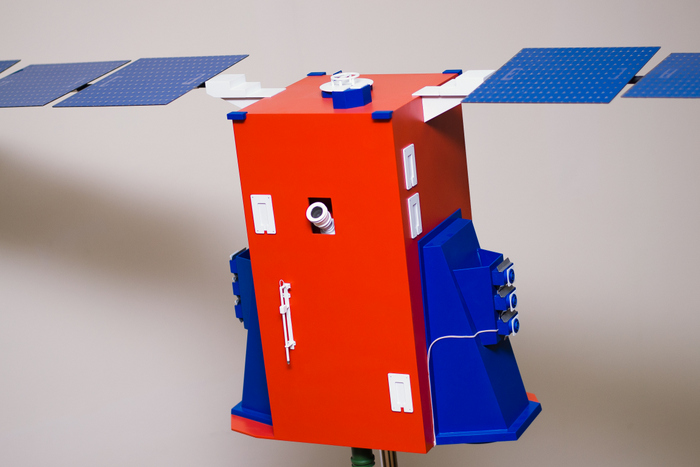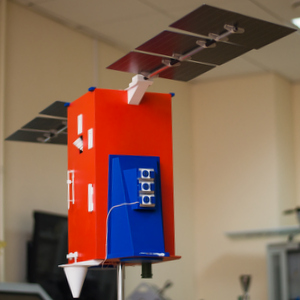The specialists of RKTs-Progress and Samara National Research University named after academician S.P. Korolev have accomplished project development of the fundamentally new “AIST-2M” small spacecraft. It is intended for receiving satellite images in stereo format and functioning within the orbital constellation.


The mass-saving “AIST-2M” spacecraft will become a follow-up of a small spacecraft “AIST” series, created in partnership with RKTs-Progress in 2008-2016.
The main purpose of the new spacecraft is remote sensing of the Earth for the purpose of acquisition of stereoscopic space images and subsequent rendering of three-dimensional land maps in high resolution on their basis.
The new small spacecraft is developed on the “AIST-2D” platform. According to project characteristics, its weight should not exceed 750 kg whereas the orbital lifetime totals at least 5 years.
“The new small spacecraft “AIST” series is due to become more effective from the viewpoint of acquisition of information about the Earth. For that, as a constituent of its equipment, it was determined to include two “Aurora” object-glasses, fundamentally new wide-cut multispectral optoelectronic equipment, which gives a stereo image”, clarified Vadim Salmin, the “AIST-2M” project coordinator, Director of Scientific Research Institute of Space Engineering at Samara University. By means of optoelectronic equipment, produced at Krasnogorskiy zavod (factory) named after S.A. Zverev and Research and Production Enterprise (RPE) “Optecs”, stereo images of the Earth surface with the resolution of about 1.2 m will be received. Along with this, the spacecraft will be in low orbits with the heights around 500 km.
“A major significance, especially during the interpretation of the terrain, has spatial (three-dimensional) form of objects. The most trustworthy method to its determination is stereoscopic photography, underscored Gennadiy Anshakov, Deputy General Designer at RKTs-Progress and Corresponding Member at RAS (Russian Academy of Sciences). In order to receive a volumetric model of the terrain, a stereoscopic pair of satellite images is used, that is to say, two adjacent overlapping images as well as special stereoscopic devices. With the help of such devices, regarding two images of one and the same object, received from two divergent angles of approach, one can not only see a stereoscopic model of the terrain, but also measure it with great accuracy”.
One more radical difference of “AIST-2M” from its predecessors is the installation of “SPD-70” electrically powered spacecraft plasma propulsion engines, manufactured at EDB (Experimental Design Bureau) “Fakel” in Kaliningrad Oblast. They allow a small spacecraft to manoeuvre in orbit and to maintain a circulation period around the Earth in the course of 5-10 years. “Owing to electrically powered spacecraft propulsion engines, “AIST-2M” can alter its position in orbit, and, consequently, solve the main task – to work within the satellite constellation”, mentioned Vadim Salmin. The project provides placing a grouping of three “AIST-2M”s into orbit. According to the Director of the Scientific Research Institute of Space Engineering at Samara University, when several satellites solve the united task, such target efficiency ratios of a space system as efficiency and frequency of observations increase.
Along with the installation of engines, project developers have suggested the version of increasing the capacity of power-supply system of the small spacecraft. “To increase the capacity, generated by solar panels, we have provided the new small spacecraft with possibility of their orientation (solar panels on “AIST-2D”are in fixed position). It will allow the panels to “keep an eye” on the Sun by means of sensors, catch incident beams at divergent angles and, thus, transfer more energy to onboard systems of the small spacecraft”, added Ivan Tkachenko, Associate Professor at the Space Engineering Department at Samara University. Besides, this solution will allow doing without the increase of areas of solar panels and, consequently, to abandon the increase of the total mass of the apparatus. For one “SPD-70” plasma engine to work, approximately 600 Watt is required; “AIST-2D”, the small spacecraft prototype, supplies with an average daily capacity of around 285 Watt.
“We expect that a vast complex of innovations will raise the efficacy of acquisition of information about the Earth, increase the lifetime of the spacecraft to 5-10 years at the expense of maintaining the parameters of the working orbit and, surely, heighten the information value of satellite images owing to stereo photography”, concluded Vadim Salmin.
For reference
Small spacecraft group of the “AIST” series:
“AIST” №1 and №2 small spacecrafts are developed by Samara University in collaboration with RKTs-Progress.
The mass of an “AIST” small spacecraft amounts to 39 kg, together with adapter – 53 kg.
Spacecraft is intended for solving educational, scientific-and-technical, and experimental tasks.
Two small spacecrafts of the first “AIST” series are placed into orbit. The launches took place on April 19 and December 23, 2013. Currently, satellites continue the work, and they are operated by TsUP (Mission Control Centre) of Samara University.
The “AIST-2D” small spacecraft was developed by the specialists of RKTs-Progress and Samara University. Optoelectronic small spacecraft is intended for remote sensing of the Earth in visible, infra-red, and radio-frequency range, not to mention for scientific experiments.
The mass of the satellite platform is about 250 kg; taking target and scientific equipment into account, the total mass of the “AIST-2D” small spacecraft constitutes 531.4 kg. According to the international classification, it is included in the niche of small spacecrafts.
The “AIST-2D” small spacecraft was placed into orbit on April 28, 2016 within the framework of the first launch from the new Russian spaceport Vostochny Cosmodrome.
In Russia, one spacecraft, “Resurs-P”, with the possibility to receive stereoscopic images functions; globally, there are more than 10 satellites of the kind.
The major applicable fields of stereoscopic images, received from the outer space, are geological exploration, forestry, glacial boundaries, mapping and study of landscape, mountain research and study of difficult terrain, determination of soil and vegetation cover, disposition of hydrographic objects.
For the effective use of satellite imagery materials, along with the images with 10-30-50-150 m resolution, the images with high spatial resolution – up to 1-2 m – are needed. Besides, the imagery should be polyzonal, and it should ensure the acquisition of stereoscopic images.
Photo: Anastasiya Korotkova (“Illuminator” photo club)
 RU
RU  EN
EN  CN
CN  ES
ES 